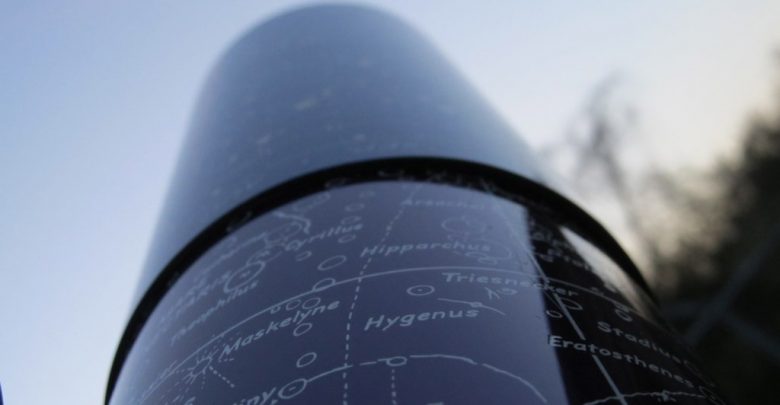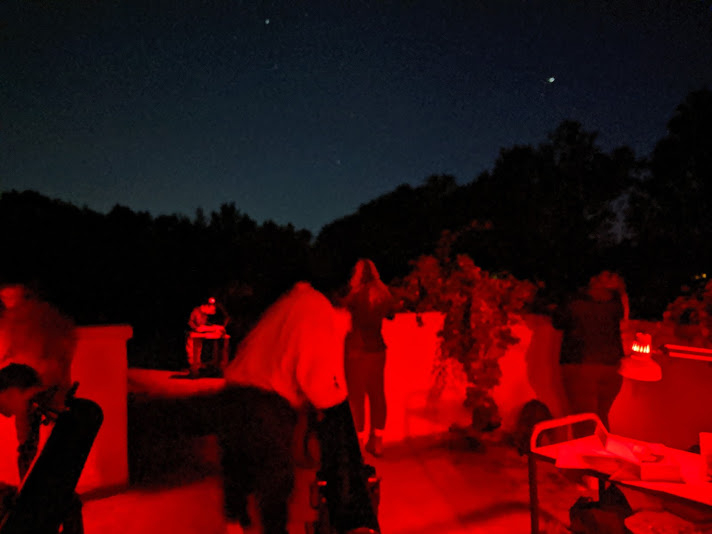
We’re coming up on the gift-giving season, and every year I get a few folks asking me, “what kind of telescope should I get for an X-year-old?” I thought it was high time to write up my own easily shareable list of tips and recommendations.
That department store scope? It’s a trap
First things first. DON’T buy a no-name brand, cheap department store telescope. Just DON’T. As Phil Plait says, this purchase “is a sure-fire way to grind someone’s enthusiasm into the ground.” It’s actually kind of amazing that I’m still doing this considering I did have one of those junkers as a kid, but I’m also kind of obsessed and stubborn.
My favorite telescope brands are Celestron, Meade, and Orion, and no, they don’t pay me to say that. This is from my experience and also recommended by many, many amateur astronomers. I honestly don’t care about giving them free advertising because they’ve been good to me over the years, especially now that I’m in charge of a small fleet of telescopes at our college.
Binoculars vs Telescopes
A lot of folks advise going for a good pair of binoculars first, but I’m going against the grain here by saying that’s not necessary. This is especially if you’ve got a kid interested in astronomy. It’s true that you can see some wonderful things with binoculars, but when you are just starting out, it’s incredibly helpful to have someone look at whatever you are looking at to confirm what you are doing. You just can’t do that with handheld binoculars, and if you’re going to invest in a good binocular tripod, well, you might as well look at telescopes. (Also, my eyes are way too close together on my face for me to use standard binoculars properly… yes really. And small kids might have the same issue.)
Solid beginner telescopes
Besides, by the time someone is asking me for advice on a telescope, they, or their kid, are really sold on the idea of having a telescope. What you get depends on your skill and interest level. I have yet to use one outside of an exhibit hall, but a great place to start is the Celestron FirstScope. (Again, totally not getting paid but I will accept bribes after the fact.) It’s compact, portable, has great optics, and is only $55. So if you suspect your kid (or adult) is just going to get bored within 6 months, you haven’t dropped a ton of money on it. I’d even suggest springing for the optional accessory kit, since more eyepieces lets you change the magnification, and Moon filters are super helpful for bringing out the contrast on your easiest astronomical target. Plus, a finderscope is key to finding fainter objects such as nebulae and star clusters. A good quality telescope at this price point was not available when I was a kid, and the FirstScope has been followed by the Orion FunScope. For something bigger that also gives to a good cause, Astronomers Without Borders has a OneSky Reflector that is available in the US.
Maybe you’re shopping for someone with a more serious interest? Maybe that person is yourself? My Astro101 college students all learn on the Orion SkyQuest XT8. And here I’ll start getting a bit more detailed about specs. Everyone wants to know, “what’s the magnification?” Forget magnification. You want aperture. This is the size (usually diameter) of the main optical element of the telescope. Think of the light coming from the stars as raindrops. You can see a faint object better when you collect more raindrops. How do you collect more raindrops? Get a big bucket! Whereas the telescopes above range from 3 to 5 inches in diameter, the SkyQuests I use have an 8-inch diameter. That’s 2.5 to 7 times more light gathering power than the ones above. Now, that also means it’s bigger, heavier, and takes a little more looking after to keep clean and in good order. At a price point around $400, it’s still a lot of light gathering power for the money, and the Dobsonian mount is so freaking easy to use. Plus, you can use the labs I’ve written for my students to get you started with it! Actually, you can use the instructions in there for any of the telescopes I’ve mentioned above, just keeping in mind that things are going to look a bit different on your scope and that you may not see all of the fainter or smaller targets quite as well. Note: I do have a range of eyepieces listed in those labs, but you can do a great job with the one included with the scope.

Gettin’ fancy
“But Nicole,” you’re saying, “aren’t telescopes computer controlled now? Can’t they just find what I want automatically?” The advent of auto-pointing technology is fantastic, but you’re going to have to pay for it. So, that’s not always a good place to start, unless you know you’re going to stick with it (and have that kind of cash in the first place.) I use our lab’s Celestron 8SE for outreach all the time. BUT… there’s a but… you still need to learn how to set up the telescope properly in order to take full advantage of its functionality. That’s not to say you have to go through using a manual telescope first, though it helps. But you will still find yourself reading manuals and star charts in the beginning as you get used to it. I find the GoTo functionality most helpful in outreach situations, when I’m trying to find objects AND entertain a crowd simultaneously.
Try before you buy
So you see you have a lot of options, depending on what you want. But don’t take my word for it. Heck, I know I have my biases and my own limited experience to draw from. Luckily, there are thousands of amateur astronomy clubs around the world full of hobbyists and semi-professionals who would just love to show you the night sky. Not only are they knowledgeable about the stars, they know a lot about telescopes. Going to a star party with such a group is a great way to see how different telescopes work in action! That way, you can make a really well-informed choice, especially if you are looking into a telescope in the higher price ranges. And, in my experience, they LOVE to see new people, particularly kids and teenagers, get involved. You can find one near you using the Night Sky Network or Sky and Telescope. When you’re ready for a real deep dive, you’ll find many telescope enthusiasts sharing what they know on the Cloudy Nights Forum.
Etc…
Finally, I always recommend picking up a book of some sort to go with your telescope gift. NightWatch is a longtime favorite of many, many backyard observers. The latest edition includes important astronomical events through the year 2025. My go-to guy when something is happening in the sky is David Dickinson, and he’s written a book with Fraser Cain called The Universe Today Ultimate Guide to Viewing the Cosmos. Yes, I’m a bit biased because I’ve worked with these guys for several years, but it really IS a comprehensive and beautiful book for amateur astronomers with different levels of experience. There is also no shortage of stargazing apps for your smart phone, and I never go out without a handy star chart and target list from Skymaps.com.
So that’s my advice in a slightly long nutshell. Clear skies!




